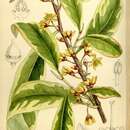en
names in breadcrumbs


Cleyera is a plant genus consisting of 21 species[1] of tender, evergreen shrubs to small trees, mostly native to Mexico and Central America, and one from Eastern Asia. In the APG III system it is placed in the family Pentaphylacaceae.[2]
The botanical name is derived from Andrew Cleyer, a Dutch physician of the seventeenth century. The plants are grown for specimen accent hedges or mixed border landscapes. Though they are slow-growing, they can eventually reach 6–10 ft (1.8-3m). The plants grow densely upright with low spreading-branch habit, round-shaped form, and can be kept compact by occasionally tip-cutting. Leaves are glossy, oval-shaped, 6–10 cm long with dark-green and bronze-red to burgundy tinted young leaves. Very fragrant small creamy white to pale yellow flowers bloom in early summer with petals free or scarcely coalesced. The pollen can cause mild allergy symptoms. Fruits are spherical, greenish yellow, turning red to black.
Cleyera is a plant genus consisting of 21 species of tender, evergreen shrubs to small trees, mostly native to Mexico and Central America, and one from Eastern Asia. In the APG III system it is placed in the family Pentaphylacaceae.
The botanical name is derived from Andrew Cleyer, a Dutch physician of the seventeenth century. The plants are grown for specimen accent hedges or mixed border landscapes. Though they are slow-growing, they can eventually reach 6–10 ft (1.8-3m). The plants grow densely upright with low spreading-branch habit, round-shaped form, and can be kept compact by occasionally tip-cutting. Leaves are glossy, oval-shaped, 6–10 cm long with dark-green and bronze-red to burgundy tinted young leaves. Very fragrant small creamy white to pale yellow flowers bloom in early summer with petals free or scarcely coalesced. The pollen can cause mild allergy symptoms. Fruits are spherical, greenish yellow, turning red to black.